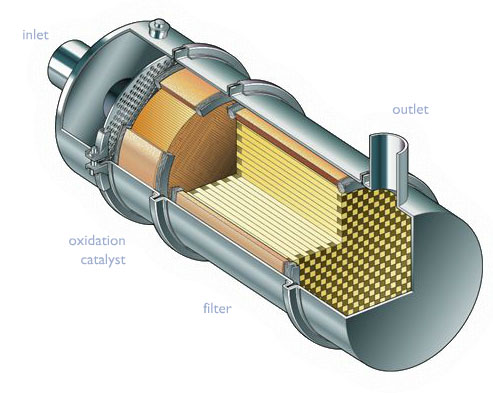Diesel Particulate Filter (DPF) Regen

DPF regen happens when the trapped particulates heat up enough to combust and turn to ash. The built-up soot is thereby removed as gaseous carbon dioxide. Regeneration may happen one of three ways:active, passive, or forced.
Active Regeneration
Active regeneration happens when changes in engine operation are required to get the ECM to burn out, or some catalyst is introduced, or both. This is common among trucks with a lighter duty cycle, because soot accumulates while idling or going slowly through traffic.
One method involves the ECM tweaking engine parameters to increase the exhaust temperature. Then it switches on an extra fuel injector that shoots fuel into the exhaust stream. This fuel reacts with a catalyst and burns the built up soot out of the DPF. Newer engines allow parked regeneration.
Passive Regeneration
Passive regeneration happens automatically. Once the exhaust temperature reaches a certain point, for example while driving at high speeds, the built up matter in the DPF turns to ash. No active changes in engine operation are involved. Diesel trucks on a heavy duty cycle, for example climbing a lot of hills, should have no problem passively regenerating their DPF. Under these conditions, soot burns off as fast as it is generated.
Forced Regeneration
When active regen requirements aren’t met, or when soot levels rise to a certain point, a forced regeneration may be required. A diagnostic tool is required to force regeneration. Continuing to operate the vehicle at this stage can ruin the DPF and cause other damage.
But even a forced regen will not work if soot levels have grown so high they have overwhelmed the DPF. At about 85% soot capacity and above, the DPF will need to be either removed and cleaned, or replaced. A new filter can cost $5,000 or more.
Cleaning
The DPF must be cleaned every 150,000 to 300,000 miles to remove accumulated ash. This ash buildup is not necessarily related to regens, but is most often due to sulfated ash in the engine oil. The filter must also be cleaned if a fuel injector or turbo problem causes contamination with engine oil or non-combusted diesel. This contamination causes unacceptable back pressure.
Cleaning methods include air blasting, water flushing, and hihg pressure air purging. Kingkar DPF cleaning machine uses both wter flushing and air purging althenate working in whole cleaning process.Puring into Kingkar DPF cleaning agent together.reaching a 100% cleaning effect.
The particulate matter removed must be carefully handled so technicians are not exposed to its extremely fine contaminants.
Timewise, cleaning a DPF should be quick enough to be accommodated during an oil change.